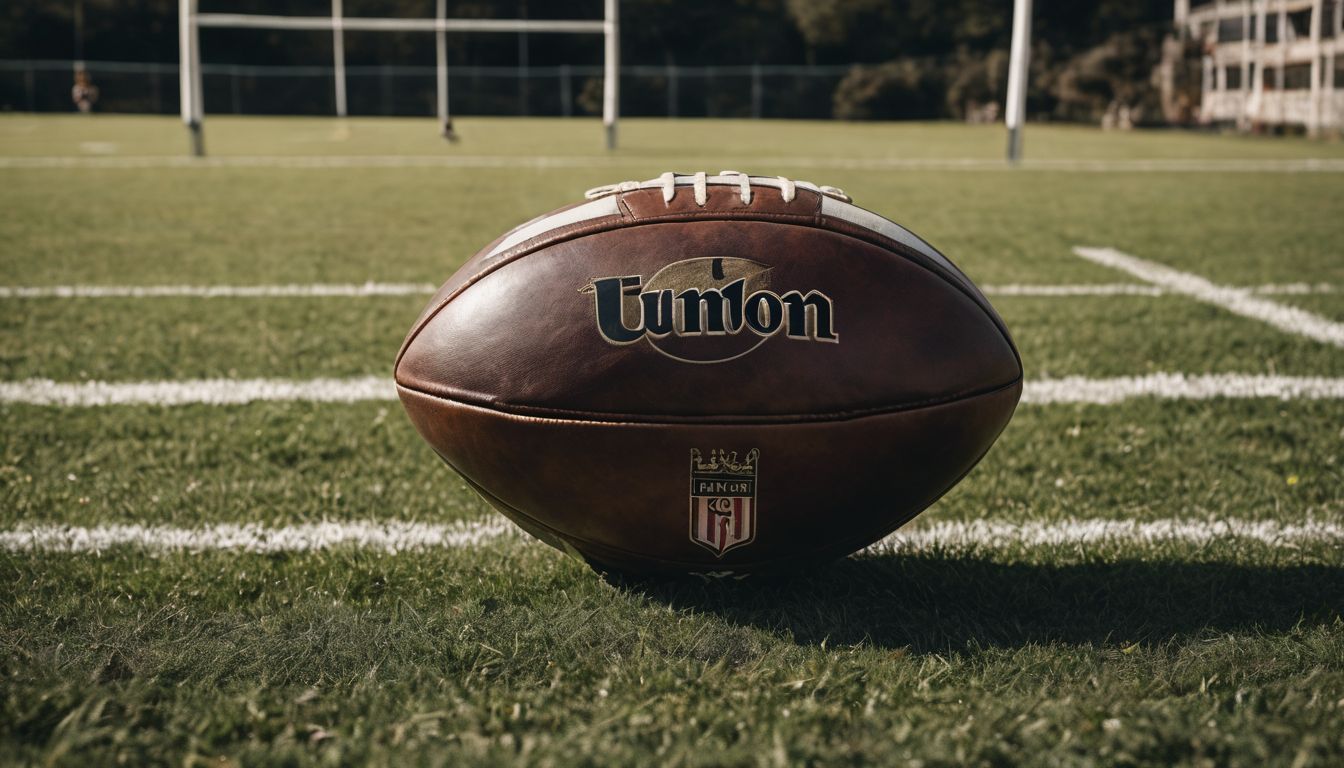Rugby fans often hear the term “conversion kick” but might not grasp its full importance in the game. A conversion is how teams add precious points after scoring a try, making it a critical play for victory.
Our blog post breaks down this key move, from rules to execution, ensuring you’ll understand each step when watching your next rugby match. Get ready to learn what makes every conversion kick a pivotal moment on the pitch!
Key Takeaways
- A conversion kick in rugby is taken after a try is scored and can add two additional points to the team’s score.
- The kicker has one minute to take the conversion kick from a spot perpendicular to where the try was placed, with sanctions for any infringements by the opposing team.
- Conversion kicks have changed from being voluntary to mandatory in rugby, reflecting strategic shifts and rule adaptations throughout the sport’s history.
- Rules vary slightly between rugby union and league, but both require precision, skill, and adherence to time limits when attempting a conversion.
- Handling of infringements during a conversion kick involves penalties such as repositioning of the attempt or awarding penalty tries.
Understanding the Conversion Kick
The conversion kick in rugby is a way to score additional points after a try has been scored. It involves kicking the ball between the goalposts and over the crossbar, with specific rules for both rugby union and league.
You are currently viewing a placeholder content from Default. To access the actual content, click the button below. Please note that doing so will share data with third-party providers.
More InformationDefinition and purpose
A conversion kick in rugby is a critical element of scoring, giving the team additional points after touching down for a try. Picture the excitement as players score a try and then prepare for this crucial follow-up play – if they succeed with their conversion kick, their team gets an extra two points to bolster their total.
Taken from where the ball was grounded during the try, it can be executed either as a place kick or a drop kick, depending on the player’s preference and strategy.
Understanding this aspect of rugby enriches your appreciation of both rugby union and league; each variant weaves its unique set of rules around what may seem like simple kicks but often become game changers.
Now let’s delve into those specific rules that distinguish between conversions in rugby union versus league.
Specific rules for rugby union and league
The specific rules for rugby union and league govern the taking of conversion kicks. In both codes, the kick must be taken perpendicular to where the try was scored. Additionally, in rugby union, a successful conversion kick adds two points to the scoring team’s total, while in rugby league, it adds two points as well.
The laws of the game dictate these rules and regulations.
When attempting a conversion kick in either rugby union or league, players are subject to time limits and sanctions if opposing teams breach any rules. It is crucial for kickers from both teams to understand and adhere to these specific rules when taking a conversion kick after a successful try has been made.
Point value
Moving on from the specific rules for rugby union and league, let’s delve into the point value of a conversion kick in rugby. When successfully executed, a conversion kick adds two points to the scoring team’s total, making it a crucial element in shaping the outcome of a game.
This simple yet high-stakes play is just one example of how strategic decision-making can directly impact match results.
The laws of the game dictate that a successful conversion kick should be awarded with two points – an addition that can significantly sway the momentum and lead changes within a match.
Steps and Requirements for Taking a Conversion Kick
When taking a conversion kick in rugby, the kicker must place the ball on a spot perpendicular to the try line. There is also a time limit for taking the kick and sanctions for opposing team infringements.
You are currently viewing a placeholder content from Default. To access the actual content, click the button below. Please note that doing so will share data with third-party providers.
More InformationSpot perpendicular to try line
The conversion kick in rugby must be taken from a spot that intersects the try line where the try was scored. This spot is perpendicular to the point where the try was placed, ensuring that the kick is aligned with the scoring.
The kicking player must take half a step backwards with their kicking foot before taking the conversion kick, maintaining accuracy and precision in their attempt.
Additionally, a successful conversion kick adds two points to the scoring team’s total and is an essential play for securing points after successfully scoring a try.
Time limit
The conversion kick in rugby must be taken within one minute from the time the try was awarded. This time limit is in place to keep the flow of the game and ensure that teams do not waste unnecessary time before taking the conversion kick.
If a team exceeds this time limit, they lose their right to attempt the conversion, and play restarts with a drop-kick from the defending team.
As part of understanding this crucial aspect of gameplay, let’s delve into the steps and requirements for taking a successful conversion kick.
Sanctions for opposing team
If the opposing team attempts to distract or disrupt the player taking the conversion kick, the referee may award a penalty. This could result in additional points being added to the scoring team’s total—two more through a successful penalty conversion kick.
The opposition must remain behind their try line and not advance until after the kicker has made contact with the ball. Should they breach this condition, it could lead to further sanctions or penalties against their team.
Such infringements can result in costly consequences for violating teams.
Key Differences Between Rugby and Football Conversion Kicks
Rugby conversion kicks are taken perpendicular to the try line, while football conversion kicks are taken from a spot parallel to the goal line. To learn more about the differences, keep reading!
You are currently viewing a placeholder content from Default. To access the actual content, click the button below. Please note that doing so will share data with third-party providers.
More InformationPlacement of kick
The placement of the kick for a conversion in rugby is crucial. It must be taken from a spot that intersects the try line where the try was scored. The kicker has to take half a step backwards with their kicking foot before taking the conversion kick, ensuring precision and accuracy.
The scoring team can choose to attempt the conversion kick as a place kick or a drop kick, adding an element of strategy and skill to this essential aspect of the game. In rugby union, the distance from which the conversion kick can be taken is perpendicular to where the try was scored, making it necessary for players to gauge both distance and angle carefully.
Handling of opposing team’s infringement
When the opposing team commits an infringement during a conversion kick, the referee has the authority to award additional opportunities for the scoring team. This can include repositioning of the conversion attempt closer to the goalposts or allowing for a retake if there is interference from the opposing team.
Referees may also penalise infringements by imposing sanctions on players who obstruct or distract the kicker, ensuring fair play and sportsmanship during this crucial phase of gameplay.
In rugby union and league, any interference by opponents during a conversion kick may result in penalties such as moving the position of where the conversion is taken or even awarding penalty tries in severe cases of obstruction.
Evolution of Conversion Kicks in Rugby
Conversion kicks in rugby have undergone significant changes throughout history, from being voluntary to mandatory and with rule adjustments along the way. To learn more about the evolution of conversion kicks in rugby, keep reading.
From voluntary to mandatory
The conversion kick in rugby has evolved from being a voluntary action to becoming mandatory after a try is scored. The scoring team now has the obligation to attempt a conversion kick, adding an additional strategic element to the game.
This change reflects the evolution of rugby and its rules over time.
Due to this development, the dynamics of the game have shifted as teams must factor in their ability to successfully convert tries into points. It adds another layer of pressure on the players taking the kicks and creates more intense moments for fans while watching matches.
Changes in rules
The rules governing conversion kicks in rugby have evolved over time, adapting to the demands and developments of the game. The most significant change came when the conversion kick changed from a voluntary attempt to being mandatory after every try.
This alteration increased the strategic importance of successful conversions, adding an extra layer of excitement and intensity to matches.
Furthermore, modifications have been made to the positioning and timing requirements for taking a conversion kick. These changes ensure that teams adhere to specific guidelines when attempting their kicks, promoting fairness and consistency across all matches.
Historical significance
The historical significance of the conversion kick in rugby can be traced back to the late 19th century when this scoring method was first introduced. The evolution of the game led to the implementation of formal rules and regulations surrounding conversion kicks, which added a new strategic dimension to rugby.
Over time, changes were made to ensure fairness and accuracy in scoring, shaping the modern approach to taking conversion kicks in both rugby union and league. The development of these rules reflects the commitment to maintaining the integrity and excitement of the sport while providing players with opportunities to showcase their skill and precision on the field.
Rugby’s history is rich with transformations, including those related to its scoring mechanisms. The incorporation of specific laws governing conversion kicks demonstrates how the sport has adapted over time, paving the way for thrilling moments that keep fans engaged and passionate about this enduring game.
Conclusion
In summary, the conversion kick in rugby is a crucial aspect of the game, adding two points to the scoring team’s total. The kicking player must position themselves perpendicular to where the try was scored and may choose between a place kick or a drop kick.
The conversion kick has evolved over time, from being voluntary to becoming mandatory with changes in rules and historical significance. Understanding its specific rules and steps for taking it ensures an exciting element within the sport for players and fans alike.
FAQs
1. What exactly is a conversion kick in rugby?
A conversion kick in rugby happens after a try or penalty try, where players can score extra points by kicking the ball between the goal posts.
2. When does a team get to attempt a conversion kick?
Teams earn the chance to go for a conversion immediately following either scoring a try by grounding the ball like a touchdown in their opponent’s in-goal area or being awarded a penalty try.
3. What do players use during a conversion kick?
During the conversion attempt, players may use specific rugby equipment such as kicking tees to help steady the ball before they try to score.
4. Where is the ball placed for taking this important kick?
The position of where players place and then take their shot at goal depends on where they’ve touched down for the try; it should align with that spot, but it can be moved back directly towards their own half to find suitable ground.
















